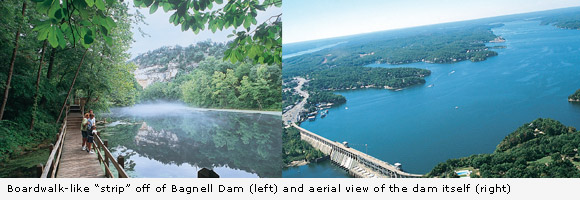Lake Lifestyle--More than Meets the Eye
Life in the Lake of the Ozarks region more than anything involves lifestyle.
Although Bagnell Dam was built in the 1920s largely to generate electricity, the area became one of Missouri's first major resort and tourism regions following the creation of the 54,000-acre lake. With more than 1,150 miles of shoreline, the Lake of the Ozarks offers more coastline than the states of Florida or California.
This sheer size may hide some things. Once seen as merely a collection of resorts and summer homes, the Lake of the Ozarks today is the definition of diversity. Its offerings a range from rustic, near wilderness experience at the huge Lake of the Ozarks State Park, to elite housing and hospitality facilities throughout the region.
One of the area's best features is a good example. Surrounding the Lake of the Ozarks are a string of communities and villages that offers unique choices and diversity for both full-time residents and visitors. With names like Climax Springs or Rocky Mount, these colorful locales don't disappoint visitors, who come for everything from arts and crafts to bed and breakfasts.
The Midwestern hospitality found in these communities has its roots the area's rich history. These northern wooded foothills of the Ozarks Mountains hold many natural springs and caves. The area that is now Miller, Camden and Morgan counties proved a perfect setting for tribes such as the Osage Indians, giants who averaged over six feet tall and reigned from the Kansas plains to this part of the Ozarks.
The first white explorers visited the region more than 300 years ago. A Frenchman named Claude DuTissent is known to have hunted here with area Indians. But it was another 100 years before Lewis and Clark noted the beauty of the Ozarks as they explored America's western frontier.
The name of the low mountain region (or big hills, take your pick) is still debated. Many believe the name is derived from the French name AuxArcs (pronounced Ozark) that was given to a post on the Arkansas River.

In the mid-1800s, communities began to grow in the region, and the new residents arrived from Kentucky, Tennessee and Virginia. These immigrants brought their mountain and bluegrass music, street dances and festivals that are still celebrated today.
The "Missouri Mule" originated on a Morgan County farm. City visitors should not laugh at these early "utility trucks." One mule earned a $10,000 prize at the 1904 St. Louis World's Fair.
The area changed considerably with the coming of the future Lake of the Ozarks. New towns sprang up during the 1920s, even while Bagnell Dam was still under construction. By the 1930s, the lake began to draw its first visitors, which caught the eye of local residents and outside investors. Almost overnight, they began to develop property for this new and growing tourist traffic. Their work ranged from roadside hotels to exclusive lodges, hamburger stands to fine restaurants.
Several businesses targeting tourist traffic focused on entertainment. In 1953, Lee Mace opened his Ozark Opry, the first Ozark country gospel music show. Other developments in-cluded everything from the boarwalk-like "Strip" off Bagnell Dam to Missouri's unique Ha Ha Tonka State Park.
 One of the most unusual business markets involved the areas underground: the many caves and springs that riddle the porous Ozarks hills. These caverns make for uncommon excursions that are also a great way to escape from summer heat or winter cold: they're a steady 55° year round. Area caves range from the almost civilized to "untamed."
One of the most unusual business markets involved the areas underground: the many caves and springs that riddle the porous Ozarks hills. These caverns make for uncommon excursions that are also a great way to escape from summer heat or winter cold: they're a steady 55° year round. Area caves range from the almost civilized to "untamed."
Residentially and commercially, the area has maintained a steady growth rate, with some unusual areas of focus. During the 1970s, many Mennonite families move to farmland located north and east of Versailles. Today, these communities continue to draw new residents and visitors with the promise of beauty, history and a sense of small-town life.
Camden County on the lake's southern shores is the region's most populated with nearly 32,000 year-round residents. Yet it's largest town, Camdenton, is home to only 2,600 people.
This "small-town" environment is also evident in the economy. In 1999, more than 25 percent of jobs available in the county were in the retail and wholesale sectors, and the second-largest employer still is the public school system. The unemployment rate varies according to the season, but averages a very high six percent.
Two large public school systems, both with AAA ratings, educate many of the area's children, although nearly every smaller community has its own district culminating in a single high school. There are five vocational and technical schools surrounding the lake, as well as satellite campuses of State Fair Community College and Drury College. A group based in Camden-ton is pursuing the possibility of establishing a permanent community college in the lake region.
The area's annual calendar is filled with festivals and other activities keep residents busy year-round. The Annual Dogwood Festival celebrates Ozark landscape, foods, crafts, art and music. Activities are held in Camdenton.
Also in May in the annual Spring Harbor Hop, a poker run involving dozens of lakeside bars and restaurants. In June, the Stoneridge Amphitheater comes alive with the Crossover Christian Music Festival.
September is a big festival month with two events beginning the Annual Hillbilly Fair in Laurie and the Annual Osage Mountain Man Rendezvous at the American Legion Campground in Lake Ozark. There's even the Mid Missouri Antique Tractor Show, complete with flea market and arts and crafts. It's held inside the Lake of the Ozarks State Park near Kaiser.
The busiest month is October. With the Old Thyme Apple Festival, the Annual Turkey Festival in Eldon, the Fall Harbor Hop and the Annual Lake of the Ozarks Dixieland Jazz Festival in Osage Beach.
But in reality, the Lake of the Ozarks remains pretty busy virtually year-round with shopping, seasonal hunting and fishing, fall leaf tours or dogwood blossom trips. The area is so diverse and its offerings so varied that something is almost always happening throughout Missouri's Lake of the Ozarks.
